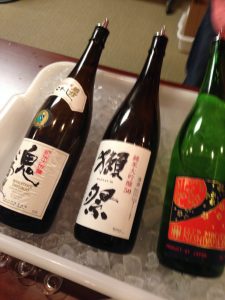Japan loves that so many people in the U.S. have become fans of their cuisine. Representatives from Japan and several U.S. Japanese experts agreed to participate in a panel discussion about Japanese cuisine and saké, held at the Japan Information Center this week. Steve Dolinsky of ABC 7 hosted the discussion as part of kickoff week for Chicago Gourmet.

In addition to the panel, several companies presented various iterations of their trademark sakés for tasting. Unlike traditional wines, saké – known as rice wine – is brewed like beer. Aromas, just as with grape-based wines, range from floral to fruity and everywhere in between. Flavors depend on the precise combination of rice, water, koji and yeast, and vary according to profile, some even made of only rice and water. Varieties also change according to how much of the rice hull is polished away before fermenting.
Panelists agreed that the sophistication of saké has grown in tandem with the curiosity of U.S. consumers. The drink has come a very long way since 30 years ago when, if you ordered saké with your dinner, in most Asian restaurants you’d get a stoneware cruet of something – room temp or heated – that was barely drinkable. Now saké breweries produce dozens of subtly different saké wines.

Panelists talked about Japanese cuisine, too, tossing around terms like dashi – a broth made of steeped bonito fish flakes and kombu – a staple of Japanese cooking. They passed around pieces of kombu (dried kelp) so that attendees could feel and smell it. Everyone agreed Asian cooking is healthy, and raising consumption is simply a matter of continuing to educate consumers about saké and Japanese cooking.
Saké comes in multiple categories (list below), and premium sakés should always be served chilled to preserve their aromas:
- Diaginjo and Ginjo – pair well with light foods and hors d’oeuvres.
- Honjozo and Junmai – pair with a wide variety of foods, from sashimi to beef.
- Bold types of saké – pair with heavier, gamier foods like cheese and beef. Bold types may include some Kimoto, Yamahai, Nama (unpasteurized) Genshu and Koshu (aged saké).
- NIgori (cloudy) saké and sparkling saké

Saké is made in hundreds of different breweries. Then like traditional wines, an importer/distributor team must agree to represent the products in the U.S. Importers include some prestigious wine importing firms like Kobrand Wine & Spirits, Terlato Wines International, and many more. Two importers present were Vine Connections – their rep Jonathan Edwards says those Bushido cans of saké (photo at top) will be in Binny’s by next week – and Tenzing Wine and Spirits, the only table present that offered samples of an unpasteurized version. Saké Boys from Kyushu was pouring samples of their premium saké (photo). Tip: their website includes brief, helpful explanations about the brewing process.
For your next meal of Asian food, talk to an expert in saké so you can experiment with pairing. How about saké and steak, Chicago?

